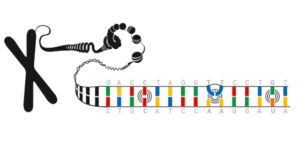The Royal Swedish Academy of Sciences has decided to award the Nobel Prize in Chemistry for 2015 to Tomas Lindahl, Francis Crick Institute and Clare Hall Laboratory, Hertfordshire, UK, Paul Modrich, Howard Hughes Medical Institute and Duke University School of Medicine, Durham, NC, USA and Aziz Sancar, University of North Carolina, Chapel Hill, NC, USA
“for mechanistic studies of DNA repair”
The cells’ toolbox for DNA repair
The Nobel Prize in Chemistry 2015 is awarded to Tomas Lindahl, Paul Modrich and Aziz Sancar for having mapped, at a molecular level, how cells repair damaged DNA and safeguard the genetic information. Their work has provided fundamental knowledge of how a living cell functions and is, for instance, used for the development of new cancer treatments.
Each day our DNA is damaged by UV radiation, free radicals and other carcinogenic substances, but even without such external attacks, a DNA molecule is inherently unstable. Thousands of spontaneous changes to a cell’s genome occur on a daily basis. Furthermore, defects can also arise when DNA is copied during cell division, a process that occurs several million times every day in the human body.
The reason our genetic material does not disintegrate into complete chemical chaos is that a host of molecular systems continuously monitor and repair DNA. The Nobel Prize in Chemistry 2015 awards three pioneering scientists who have mapped how several of these repair systems function at a detailed molecular level.
In the early 1970s, scientists believed that DNA was an extremely stable molecule, but Tomas Lindahl demonstrated that DNA decays at a rate that ought to have made the development of life on Earth impossible. This insight led him to discover a molecular machinery, base excision repair, which constantly counteracts the collapse of our DNA.
Aziz Sancar has mapped nucleotide excision repair, the mechanism that cells use to repair UV damage to DNA. People born with defects in this repair system will develop skin cancer if they are exposed to sunlight. The cell also utilises nucleotide excision repair to correct defects caused by mutagenic substances, among other things.
Paul Modrich has demonstrated how the cell corrects errors that occur when DNA is replicated during cell division. This mechanism, mismatch repair, reduces the error frequency during DNA replication by about a thousandfold. Congenital defects in mismatch repair are known, for example, to cause a hereditary variant of colon cancer.
The Nobel Laureates in Chemistry 2015 have provided fundamental insights into how cells function, knowledge that can be used, for instance, in the development of new cancer treatments.

Tomas Lindahl, Swedish citizen. Born 1938 in Stockholm, Sweden. Ph.D. 1967 from Karolinska Institutet, Stockholm, Sweden. Professor of Medical and Physiological Chemistry at University of Gothenburg 1978–82. Emeritus group leader at Francis Crick Institute and Emeritus director of Cancer Research UK at Clare Hall Laboratory, Hertfordshire, UK.
Paul Modrich, U.S. citizen. Born 1946. Ph.D. 1973 from Stanford University, Stanford, CA, USA. Investigator at Howard Hughes Medical Institute and James B. Duke Professor of Biochemistry at Duke University School of Medicine, Durham, NC, USA.
Aziz Sancar, U.S. and Turkish citizen. Born 1946 in Savur, Turkey. Ph.D. 1977 from University of Texas, Dallas, TX, USA. Sarah Graham Kenan Professor of Biochemistry and Biophysics, University of North Carolina School of Medicine, Chapel Hill, NC, USA.
Prize amount: 8 million Swedish krona, to be shared equally between the laureates.
The Royal Swedish Academy of Sciences, founded in 1739, is an independent organisation whose overall objective is to promote the sciences and strengthen their influence in society. The Academy takes special responsibility for the natural sciences and mathematics, but endeavours to promote the exchange of ideas between various disciplines.
Nobel Prize® and the Nobel Prize® medal design mark are registered trademarks of the Nobel Foundation.
More information
The Laureates
Tomas Lindahl, Francis Crick Institute
Paul Modrich, Duke University School of Medicine
Aziz Sancar, University of North Carolina School of Medicine
Popular science articles
Howard Hughes Medical Institute, Biography Paul Modrich
Weston, K. (2014) Country Life: Repair and Replication. In Blue Skies and Bench Space: Adventures in Cancer Research. Long Island, New York, Cold Spring Harbor Laboratory Press
Zagorski, N. (2005) Profile of Aziz Sancar, Proc. Nat. Acad. Sci. USA, 102(45), 16125–16127
Videos
Howard Hughes Medical Institute (2003) Mismatch repair
Interview with T. Lindahl (2015) Cancer Research UK
Scientific articles
Lahue, R. S, Au, K. G. och Modrich, P. (1989) DNA Mismatch Correction in a Defined System, Science, 245(4914), 160–164.
Lindahl, T. (1974) An N-Glycosidase from Escherichia coli That Releases Free Uracil from DNA Containing Deaminated Cystosine Residues, Proc. Nat. Acad. Sci. USA, 71(9), 3649–3653.
Sancar, A. och Rupp, W. D. (1983) A Novel Repair Enzyme: UVRABC Excision Nuclease of Escherichia coil Cuts a DNA Strand on Both Sides of the Damaged Region, Cell, 33(1), 249–260.